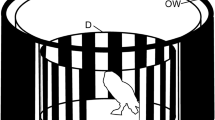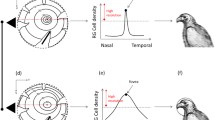Summary
Measurements were made of the physical properties of the visual system of the zebra finch, a bird with laterally placed eyes. The use of the visual system in pecking and courtship behavior was examined. It was demonstrated that the optical axis and the fovea of the eye point in a direction about 62° from the sagittal axis of the head. The visual field of each eye covers about 170° in the horizontal plane. In the frontal region there is an overlap of about 30°–40° where the birds can see binocularly; caudally there is a ‘gap’ in the visual field of 60°. The point of best binocular viewing is in the sagittal plane at 16.5° below the beak.
Concerning movement detection, the upper threshold is 540°/s for the binocular (frontal) part of the visual field and about 1100°/s for the monocular (lateral) part. Most fixations before pecking occur monocularly. A preference for one eye during pecking was not detected. During the courtship song, a male bird directs its head towards the female. The results are discussed in comparison with findings in pigeons and chickens.
Similar content being viewed by others
References
Bischof HJ (1985) Der Anteil akustischer Komponenten an der Auslösung der Balz männlicher Zebrafinken (Taeniopygia guttata castanotis). J Ornithol 126:273–279
Bloch S, Martinoya C (1978) Comparison of frontal and lateral visual acuity of the pigeon under behavioral fixation. J Physiol (Lond) 278:49 P
Bloch S, Martinoya C (1982) Comparing frontal and lateral viewing in the pigeon. I. Tachistoscopic visual acuity as a function of distance. Behav Brain Res 5:231–244
Bloch S, Martinoya C, Rivaud S (1981) Eye movements in birds: participation in binocular fixation and visual pursuit. J Physiol (Lond) 320:20–21
Bloch S, Riveaud S, Martinoya C (1984) Comparing frontal and lateral viewing in the pigeon. III. Different patterns of eye movements for binocular and monocular fixation. Behav Brain Res 13:173–182
Catania AC (1963) Techniques for the control of monocular and binocular viewing in the pigeon. J Exp Anal Behav 6:627–629
Donovan WJ (1978) Structure and function of the pigeon visual system. Physiol Psychol 6:403–437
Emmerton J (1983 a) Functional morphology of the visual system. In: Abs M (ed) Physiology and behavior of the pigeon. Academic, London, pp 221–241
Emmerton J (1983b) Vision. In: Abs M (ed) Physiology and behavior of the pigeon. Academic, London, pp 245–266
Friedman MB (1975) How birds use their eyes. In: Wright P, Caryl P, Vowles DM (eds) Neural and endocrine aspects of behavior in birds. Elsevier, Amsterdam, pp 181–204
Goodale MA (1983) Visually guided pecking in the pigeon (Columba livia). Brain Behav Evol 22:22–41
Güntürkün O (1985) Lateralization of visually controlled behavior in pigeons. Physiol Behav 34:575–577
Immelmann K (1959) Experimentelle Untersuchungen über die biologische Bedeutung artspezifischer Merkmale beim Zebrafinken (Taeniopygia guttata castanotis GOULD). Zool Jb 86:438–593
Marshall J, Mellerio J, Palmer DA (1973) A schematic eye for the pigeon. Vision Res 13:2449–2453
Martin GR (1986a) The eye of a passeriform bird, the European starling (Sturnus vulgaris): eye movement amplitude, visual fields and schematic optics. J Comp Physiol A 159:545–557
Martin GR (1986b) Total panoramic vision in the mallard duck,Anas platyrhynchos. Vision Res 26:1303–1305
Martinoya C, Rey J, Bloch S (1981) Limits of the pigeon's binocular field and direction for best binocular viewing. Vision Res 21:1197–1200
Martinoya C, Riveaud S, Bloch S (1983) Comparing frontal and lateral viewing in the pigeon. II. Velocity thresholds for movement discrimination. Behav Brain Res 8:375–385
Martinoya C, Le Houezec J, Bloch S (1984) Pigeon's eyes converge during feeding: evidence for frontal binocular fixation in a lateral-eyed bird. Neurosci Lett 45:335–339
McFadden SA, Reymond L (1985) A further look at the binocular visual field of the pigeon (Columba livid). Vision Res 25:1741–1746
Mench JA, Andrew RJ (1986) Lateralization of a food search task in the domestic chick. Behav Neural Biol 46:107–114
Meyer DB (1977) The avian eye and its adaptations. In: Crescitelli F (ed) The visual system in vertebrates. (Handbook of sensory physiology, vol VII/5) Springer, Berlin Heidelberg New York, pp 549–611
Morris D (1954) The reproductive behavior of the zebra finch. Behaviour 6:271–322
Nye PW (1973) On the functional differences between frontal and lateral visual fields of the pigeons. Vision Res 13:559–574
Workman L, Andrew RJ (1986) Asymmetries of eye use in birds. Anim Behav 34:1582–1585
Author information
Authors and Affiliations
Rights and permissions
About this article
Cite this article
Bischof, H.J. The visual field and visually guided behavior in the zebra finch (Taeniopygia guttata). J. Comp. Physiol. 163, 329–337 (1988). https://doi.org/10.1007/BF00604008
Accepted:
Issue Date:
DOI: https://doi.org/10.1007/BF00604008




